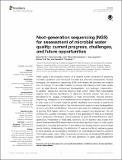Next-generation sequencing (NGS) for assessment of microbial water quality: current progress, challenges, and future opportunities
Author(s)
Tan, BoonFei; Ng, Charmaine; Nshimyimana, Jean Pierre; Loh, Lay Leng; Gin, Karina Y.-H.; Thompson, Janelle Renee; ... Show more Show less
DownloadTan-2015-Next-generation sequ.pdf (1.083Mb)
PUBLISHER_CC
Publisher with Creative Commons License
Creative Commons Attribution
Terms of use
Metadata
Show full item recordAbstract
Water quality is an emergent property of a complex system comprised of interacting microbial populations and introduced microbial and chemical contaminants. Studies leveraging next-generation sequencing (NGS) technologies are providing new insights into the ecology of microbially mediated processes that influence fresh water quality such as algal blooms, contaminant biodegradation, and pathogen dissemination. In addition, sequencing methods targeting small subunit (SSU) rRNA hypervariable regions have allowed identification of signature microbial species that serve as bioindicators for sewage contamination in these environments. Beyond amplicon sequencing, metagenomic and metatranscriptomic analyses of microbial communities in fresh water environments reveal the genetic capabilities and interplay of waterborne microorganisms, shedding light on the mechanisms for production and biodegradation of toxins and other contaminants. This review discusses the challenges and benefits of applying NGS-based methods to water quality research and assessment. We will consider the suitability and biases inherent in the application of NGS as a screening tool for assessment of biological risks and discuss the potential and limitations for direct quantitative interpretation of NGS data. Secondly, we will examine case studies from recent literature where NGS based methods have been applied to topics in water quality assessment, including development of bioindicators for sewage pollution and microbial source tracking, characterizing the distribution of toxin and antibiotic resistance genes in water samples, and investigating mechanisms of biodegradation of harmful pollutants that threaten water quality. Finally, we provide a short review of emerging NGS platforms and their potential applications to the next generation of water quality assessment tools.
Date issued
2015-09Department
Massachusetts Institute of Technology. Department of Civil and Environmental EngineeringJournal
Frontiers in Microbiology
Publisher
Frontiers Research Foundation
Citation
Tan, BoonFei, Charmaine Ng, Jean Pierre Nshimyimana, Lay Leng Loh, Karina Y.-H. Gin, and Janelle R. Thompson. “Next-Generation Sequencing (NGS) for Assessment of Microbial Water Quality: Current Progress, Challenges, and Future Opportunities.” Frontiers in Microbiology 6 (September 25, 2015).
Version: Final published version
ISSN
1664-302X